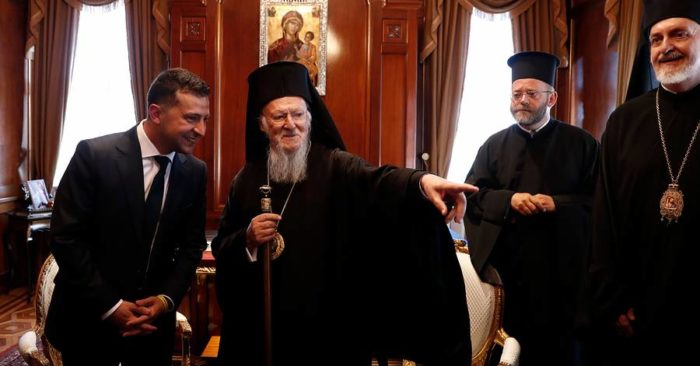
BROWSER UPDATE To gain access to the full experience, please upgrade your browser:
Note: If you are running Internet Explorer 10 and above, make sure it is not in compatibility mode
https://www.wsj.com/articles/ukraine-gets-a-church-of-its-ownand-vladimir-putin-glowers-11566576051
The ceremony for a cathedral being built to honor Russia’s military was a potent public demonstration of the newly tightened bond between church and state in a country that was officially atheist for decades under the Soviets. Mr. Putin’s alliance with the church is central to his efforts to represent a regional bulwark against the West and to help keep the largely Orthodox former Soviet republics—especially Ukraine—under his wing.
Since then, Russia has suspended communion with the church of the 79-year-old Bartholomew, accusing him of overstepping his authority and denouncing him as a U.S. puppet. Mr. Putin has said that Bartholomew was duped into the move, motivated by money and “prompting from Washington.” A top Russian Orthodox bishop accused Bartholomew of having been paid $25 million for his pro-Ukraine decision, citing unsubstantiated claims in the state-dominated Russian media. For their part, Bartholomew and his advisers say that Russia is using Soviet-style dark arts against him, including disinformation, and has tried to hack church emails.
How will Ukraine’s church affect Russian President Vladimir Putin’s ambitions? Join the conversation below.
The conflict has brought into the open a long-simmering competition for sway within the Eastern Orthodox Church, the world’s second-largest Christian denomination, with some 250 million followers. Bartholomew—who is based in Istanbul, the former capital of the Roman Empire once known as Constantinople—is “first among equals” of Orthodox leaders. But the Russian church, the biggest member of the loosely knit organization, has long used its size and wealth to challenge his authority. (Around two-thirds of Ukrainians identify as Orthodox, while some 10% of Ukrainians are Greek Catholic.)
All sides are lobbying other Orthodox churches that are considering whether to recognize the new Ukrainian church. None has done so yet, which the Russian Orthodox Church says shows the weakness of Bartholomew’s authority. Meanwhile, each side is looking for any sign that it has the upper hand. After a senior bishop from the Church of Greece appeared at a ceremony in Kiev on July 28, the Greek bishop’s office issued a disclaimer to clarify that his presence wasn’t an endorsement.
Metropolitan Emmanuel of France, a close adviser to Bartholomew, said in an interview that it may be some time before other churches grant recognition to the new Ukrainian church. “We don’t live in the same sense of time as the political world,” he said.
Orthodoxy has long glued Russia and Ukraine together. The religion first came to Russia via Kiev. Volodymyr the Great—or Vladimir the Great, as Russians call him—adopted the faith at the end of the first millennium, when Kiev was pre-eminent among eastern Slavs. As Moscow became a regional power over the following centuries, it acquired its own religious authority. In 1686, an ambassador of the Russian czar cajoled a distant predecessor of Bartholomew’s into permitting Moscow to install its own church leader in Kiev.
The Soviet Union largely suppressed religion during the 20th century, but after the KGB veteran Mr. Putin came to power in 2000, the Russian Orthodox Church became his firm ally. The Kremlin leader and allied tycoons have used religion to spread political power at home and abroad, funding conservative organizations, television channels and the construction of churches. The Russian Orthodox Church’s leader, Patriarch Kirill, has called Mr. Putin’s period of rule a “miracle of God” and says that three churches are being built in Russia every day. Meanwhile, Mr. Putin has adopted St. Vladimir as an icon of the historic and cultural ties of the region. The Russian leader had a nearly 60-foot statue of his namesake built near the Kremlin in 2016 and partly justified his 2014 annexation of Ukraine’s Crimean peninsula by saying that it was where the saint was baptized.
Ukraine’s efforts to carve out its own Orthodox church began soon after the country gained independence from Moscow in 1991 after the collapse of the Soviet Union. For years, Ukrainian appeals to Bartholomew for its own church went unfulfilled, partly thwarted by Russian obstruction. But Russia’s invasion of Ukraine in 2014 sparked a national awakening and turned most Ukrainians against anything connected with their erstwhile imperial masters in Moscow. The upstart Kiev Patriarchate’s popularity surged, and individual Ukrainian churches began ousting Russia-linked priests.
Bartholomew proceeded cautiously, trying to assuage Moscow to preserve its support for his own yearslong effort to put together a Holy and Great Council—a meeting of the leaders of all 14 officially recognized Orthodox churches, the likes of which hadn’t taken place for more than a millennium. Russia pulled out of the gathering at the last minute, which dimmed the luster of Bartholomew’s crowning achievement. Metropolitan Emmanuel described the Russian withdrawal as “an attempted coup” aimed at undermining Bartholomew. But it did untie his hands on Ukraine.
The Eastern Orthodox leader told his aides not to worry about the Russian campaign, saying that he wanted to heal a wound in Ukraine that had kept millions of people cut off from the official church. Bartholomew officially granted autocephaly—independence from external authority—to the Orthodox Church of Ukraine on Jan. 6 in a ceremony in Istanbul.
Write to James Marson at [email protected]
